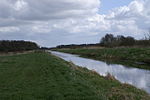Ashcott railway station
Beeching closures in EnglandDisused railway stations in SomersetFormer Somerset and Dorset Joint Railway stationsPages with no open date in Infobox stationRailway stations in Great Britain closed in 1966 ... and 2 more
Railway stations in Great Britain opened in 1856Use British English from December 2014

Ashcott railway station was a station on the Highbridge branch of the Somerset and Dorset Joint Railway. Opened by the Somerset Central Railway in 1856 as Ashcott and Meare, the name changed to Ashcott in 1876. Consisting of a short wooden platform and station building, the station was next to a road level crossing. This was operated with a 10 lever ground frame.
Excerpt from the Wikipedia article Ashcott railway station (License: CC BY-SA 3.0, Authors, Images).Ashcott railway station
Station Road,
Geographical coordinates (GPS) Address Nearby Places Show on map
Geographical coordinates (GPS)
| Latitude | Longitude |
|---|---|
| N 51.15389 ° | E -2.78921 ° |
Address
Station Road
BA6 9SX , Ashcott
England, United Kingdom
Open on Google Maps








